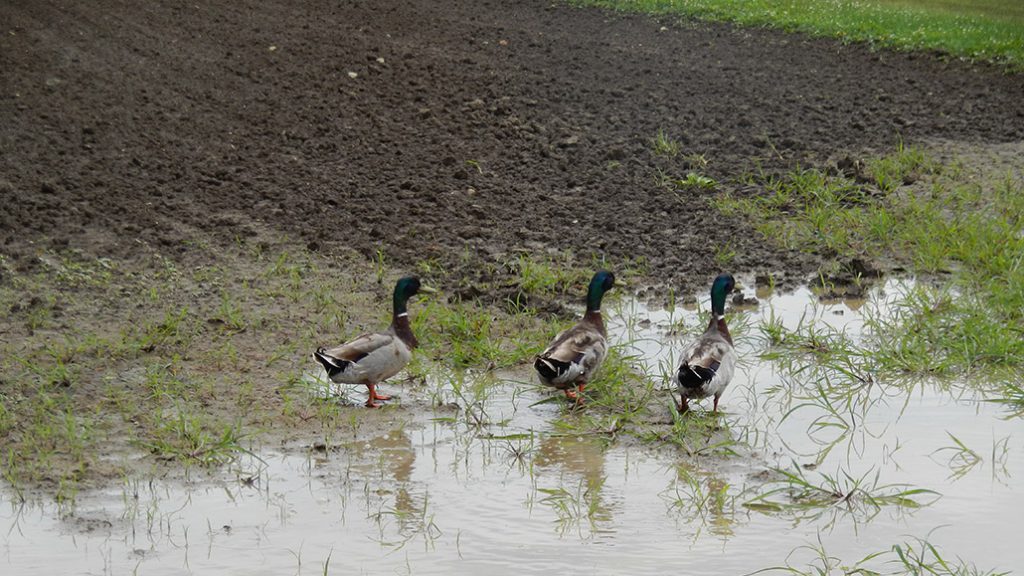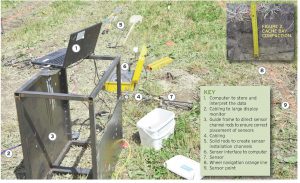How resistant weeds spread
THE CHALLENGE OF NATURE

THERE ARE CURRENTLY 21 known herbicide resistant weeds in Ontario. These include Canada Fleabane, Giant Ragweed, Common Ragweed, Waterhemp, and Red Root Pigweed. Despite the best efforts of farmers to stop the spread of these weeds, many species are invading new areas of the province — and it could be due to factors beyond our control.
Wind, birds, and even earthworms are known dispersal mechanisms for weed seeds. Some are also spread along waterways. Dave Bilyea, weed science technician at the University of Guelph Ridgetown Campus, highlighted these issues during the 2018 Southwest Crop Diagnostic Days.
“Some of the weeds on the herbicide resistant list are not so apt to jump out at you, but they all have effective dispersal methods,” says Bilyea. “When you see that a weed has escaped your controls, you need to ask why did it escape, and check to see if the weed is on the list.”
WIND AND WATER
Confirmed populations of Canada fleabane, that are resistant to Group 2 and Group 9 herbicides, have been detected moving across the province. Wind blown seeds, the majority of which will germinate upon dispersal, have allowed the weed to spread and grow in non-crop areas.
“Research has proven that these seeds, with the fluff, or pappus, that is on them, are able to get into the interplanetary boundary and they can actually be moved great distances,” explains Bilyea. “Research using weather balloons has captured seed up to 1,000 metres in the air and determined that seeds can be moved up to 500 kilometres away.”
Canada fleabane seeds are also buoyant and can move even farther along waterways. Some other herbicide resistant weeds, such as Green Foxtail (Group 2 resistant) and Cocklebur (Group 5 resistant), also have floating seeds which is aiding their spread.
New technology developed in Australia, known as the Harrington seed destructor, cracks weed seeds during harvest — preventing the seeds from being viable if they are carried away by the wind or end up in waterways. However, Bilyea says this isn’t effective for all weeds, some of them, particularly the foxtails, have already shed the majority their seeds by the time harvest begins in the fall.
BIRDS
Researchers at the University of Missouri have discovered that migratory wildfowl, especially ducks, are the reason attempts to control the spread of herbicide resistant Waterhemp (Groups 2, 5, and 9) and Palmer Amaranth (Group 9) have failed. Palmer Amaranth is not yet a problem in Ontario, but it has become a major issue in fields south of the border. It has spread far beyond the cotton fields of West Texas, and in 2016 it was named as the most troublesome weed in the U.S. by the Weed Science Society of America.
The Missouri researchers believe that the birds are seeking out the seeds of these weeds because they contain lipids which they require for nesting. Researchers discovered they seem to prefer Waterhemp and Palmer Amaranth since ducks collected from hunters had eaten them in abundance.
To determine just how far birds are responsible for the spread of these particular weeds, researchers conducted feeding studies on how long it took caged ducks to digest the seeds and retention time before defecation. Then they looked at known average flight speed and possible distance flown by ducks based on the retention time.
Currently, their findings are all hypothetical but Bilyea says they are actually quite probable. Researchers believe ducks potentially could carry herbicide resistant Waterhemp and Palmer amaranth all the way from Missouri to Quebec.
“That’s a long distance, and as ducks land and digest the seeds they are going to build up weed populations in areas that aren’t naturally scouted,” says Bilyea. “Pennsylvania, Michigan, Ohio, Wisconsin — all of these neighbouring states have Palmer Amaranth now and as it gets closer to the border waterfowl can bring it here. You can’t escape the reality — we already have Waterhemp and we are going to have Palmer.”
In addition to birds, Palmer Amaranth is also being spread in the U.S. by livestock who are fed contaminated cotton hulls or hay and then shipped to feedlots in other states. Contaminated manure spread on fields is also a concern in the Midwest. Large areas of U.S. conservation land have also been seeded with wildflower seed mix recently discovered to be contaminated with Palmer Amaranth seed.
EARTHWORMS
Ducks and geese aren’t the only ones with a preference for a specific weed — earthworms actively seek out Giant Ragweed (Group 2 and 9 resistant).
“A lot of people were surprised to hear this,” says Bilyea of those in attendance during his Diagnostic Days presentations. “But when researchers at Ohio State University dug into why the frequency of Giant Ragweed had increased, they found earthworms were dragging the seed down into their burros. They don’t know why it’s happening, but they do know they prefer these seeds.”
Studies have shown that as much as 60 per cent of available seed in a field is being pulled down. This increases the potential for a new weed to emerge. In some cases, it is being pulled down 22 centimetres, which is deep enough for the seed to lie dormant — in essence creating a seed bank of Giant Ragweed.
Bilyea says if the Giant Ragweed is removed before going to seed, this won’t happen; but it can go to seed before being detected in headlands or remote parts of a field. And if corn harvest is late, the seed will already be on the ground.
SCOUTING
While it may be discouraging to learn that nature is working against the battle to control herbicide resistant weeds, Bilyea says it’s important that farmers continue to scout regularly and control weed populations using multiple modes of action to reduce the development of resistance.
“You might see a weed that is new to you, but it’s actually common — it’s just been newly spread to you,” says Bilyea. “You do need to pay attention to anything that looks unusual. When you find a weed that should be controlled and wasn’t, it’s worth noting that maybe we have a weed that’s not normal and maybe you need someone to come and take a second look.”
A full list of herbicide resistant weeds can be found in the OMAFRA Publication 75, Guide to Weed Control, available online at http://www.omafra.gov.on.ca/english/crops/ pub75/pub75toc.htm.
Herbicide resistant weed testing is offered by researchers at the University of Guelph. Contact Dr. Francois Tardif (ftardif@uoguelph.ca) or Peter Smith (pssmith@uoguelph.ca), or call 519-824-4120 ext. 52580. •



























